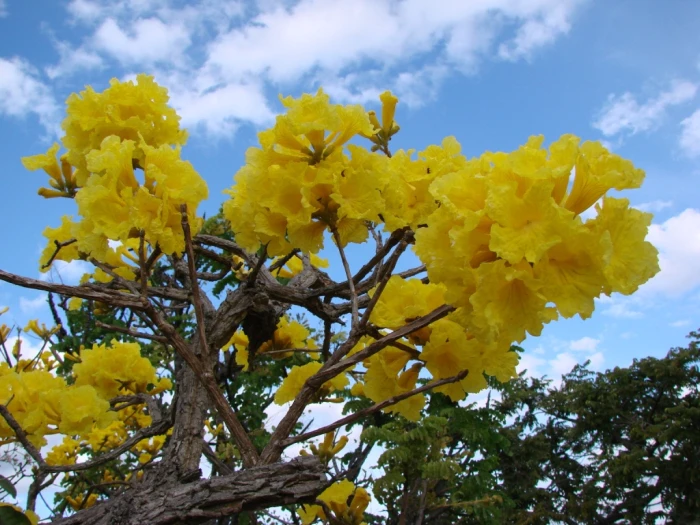Yellow Trumpet Tree
(Handroanthus ochraceus)
Yellow Trumpet Tree (Handroanthus ochraceus)
/
/

João Medeiros
CC BY 2.0
Image By:
João Medeiros
Recorded By:
Copyright:
CC BY 2.0
Copyright Notice:
Photo by: João Medeiros | License Type: CC BY 2.0 | License URL: https://creativecommons.org/licenses/by/2.0 | Uploader: Matanya | Publisher: Wikimedia Commons |


















Estimated Native Range
Climate Requirements for Shanghai, China
| This Plant | Your Site | Plant Suitability for Your Location | ||
|---|---|---|---|---|
| • Precipitation | 7" - 158" | 43" | Aquatic | Aquatic |
| • High Temp. | 64°F - 97°F | 88°F | Your summer temperatures are normal for this plant. | Excellent |
| • Low Temp. | 22°F - 73°F | 35°F | Your winter temperatures are normal for this plant | Excellent |
This plant should grow well at your location with about N inches per year (Y minutes per month) of irrigation.
Summary
Handroanthus ochraceus, commonly known as Yellow Trumpet Tree, is a deciduous tree native to the seasonally dry tropical forests and savannas from Central America to Argentina. It typically grows to a height of 40-50 feet (12-15 meters) and a width of 25-30 feet (8-9 meters). The tree is known for its showy, bright yellow flowers that bloom in clusters, primarily in the spring and early summer, before the new foliage emerges. The bark is furrowed and the tree may produce winged seed capsules after flowering.
The Yellow Trumpet Tree is valued for its vibrant floral display and is often used as an ornamental tree in tropical and subtropical landscapes. It is suitable for urban planting due to its moderate size and is also used as a shade tree or accent plant in larger gardens. The tree is drought-tolerant once established, making it a good choice for xeriscaping. It prefers well-drained soils and can tolerate a range of soil types, from sandy to clay. While it thrives in full sun, it can also adapt to part shade. Gardeners should be aware that it can be susceptible to pests such as aphids and diseases like root rot if conditions are too wet.CC BY-SA 4.0
The Yellow Trumpet Tree is valued for its vibrant floral display and is often used as an ornamental tree in tropical and subtropical landscapes. It is suitable for urban planting due to its moderate size and is also used as a shade tree or accent plant in larger gardens. The tree is drought-tolerant once established, making it a good choice for xeriscaping. It prefers well-drained soils and can tolerate a range of soil types, from sandy to clay. While it thrives in full sun, it can also adapt to part shade. Gardeners should be aware that it can be susceptible to pests such as aphids and diseases like root rot if conditions are too wet.CC BY-SA 4.0
Plant Description
- Plant Type: Tree
- Height: 40-50 feet
- Width: 25-30 feet
- Growth Rate: Moderate
- Flower Color: Yellow
- Flowering Season: Spring, Summer
- Leaf Retention: Deciduous
Growth Requirements
- Sun: Full Sun, Part Shade
- Water: Low, Medium
- Drainage: Medium
Common Uses
Bee Garden, Bird Garden, Butterfly Garden, Hummingbird Garden, Low Maintenance, Showy Flowers
Natural Habitat
native to the seasonally dry tropical forests and savannas from Central America to Argentina
Other Names
Common Names: Corteza Amarillia
Scientific Names: Handroanthus ochraceus, Tabebuia hypodicton, Tecoma hypodicton
GBIF Accepted Name: Handroanthus ochraceus (Cham.) Mattos